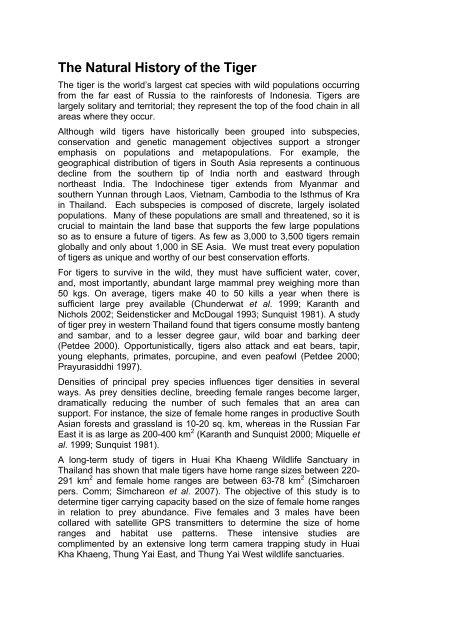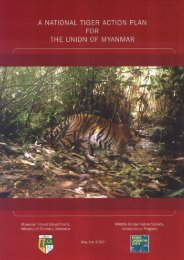Thailand Tiger Action Plan - Global Tiger Initiative
Thailand Tiger Action Plan - Global Tiger Initiative
Thailand Tiger Action Plan - Global Tiger Initiative
You also want an ePaper? Increase the reach of your titles
YUMPU automatically turns print PDFs into web optimized ePapers that Google loves.
The Natural History of the <strong>Tiger</strong>The tiger is the world’s largest cat species with wild populations occurringfrom the far east of Russia to the rainforests of Indonesia. <strong>Tiger</strong>s arelargely solitary and territorial; they represent the top of the food chain in allareas where they occur.Although wild tigers have historically been grouped into subspecies,conservation and genetic management objectives support a strongeremphasis on populations and metapopulations. For example, thegeographical distribution of tigers in South Asia represents a continuousdecline from the southern tip of India north and eastward throughnortheast India. The Indochinese tiger extends from Myanmar andsouthern Yunnan through Laos, Vietnam, Cambodia to the Isthmus of Krain <strong>Thailand</strong>. Each subspecies is composed of discrete, largely isolatedpopulations. Many of these populations are small and threatened, so it iscrucial to maintain the land base that supports the few large populationsso as to ensure a future of tigers. As few as 3,000 to 3,500 tigers remainglobally and only about 1,000 in SE Asia. We must treat every populationof tigers as unique and worthy of our best conservation efforts.For tigers to survive in the wild, they must have sufficient water, cover,and, most importantly, abundant large mammal prey weighing more than50 kgs. On average, tigers make 40 to 50 kills a year when there issufficient large prey available (Chunderwat et al. 1999; Karanth andNichols 2002; Seidensticker and McDougal 1993; Sunquist 1981). A studyof tiger prey in western <strong>Thailand</strong> found that tigers consume mostly bantengand sambar, and to a lesser degree gaur, wild boar and barking deer(Petdee 2000). Opportunistically, tigers also attack and eat bears, tapir,young elephants, primates, porcupine, and even peafowl (Petdee 2000;Prayurasiddhi 1997).Densities of principal prey species influences tiger densities in severalways. As prey densities decline, breeding female ranges become larger,dramatically reducing the number of such females that an area cansupport. For instance, the size of female home ranges in productive SouthAsian forests and grassland is 10-20 sq. km, whereas in the Russian FarEast it is as large as 200-400 km 2 (Karanth and Sunquist 2000; Miquelle etal. 1999; Sunquist 1981).A long-term study of tigers in Huai Kha Khaeng Wildlife Sanctuary in<strong>Thailand</strong> has shown that male tigers have home range sizes between 220-291 km 2 and female home ranges are between 63-78 km 2 (Simcharoenpers. Comm; Simchareon et al. 2007). The objective of this study is todetermine tiger carrying capacity based on the size of female home rangesin relation to prey abundance. Five females and 3 males have beencollared with satellite GPS transmitters to determine the size of homeranges and habitat use patterns. These intensive studies arecomplimented by an extensive long term camera trapping study in HuaiKha Khaeng, Thung Yai East, and Thung Yai West wildlife sanctuaries.
















